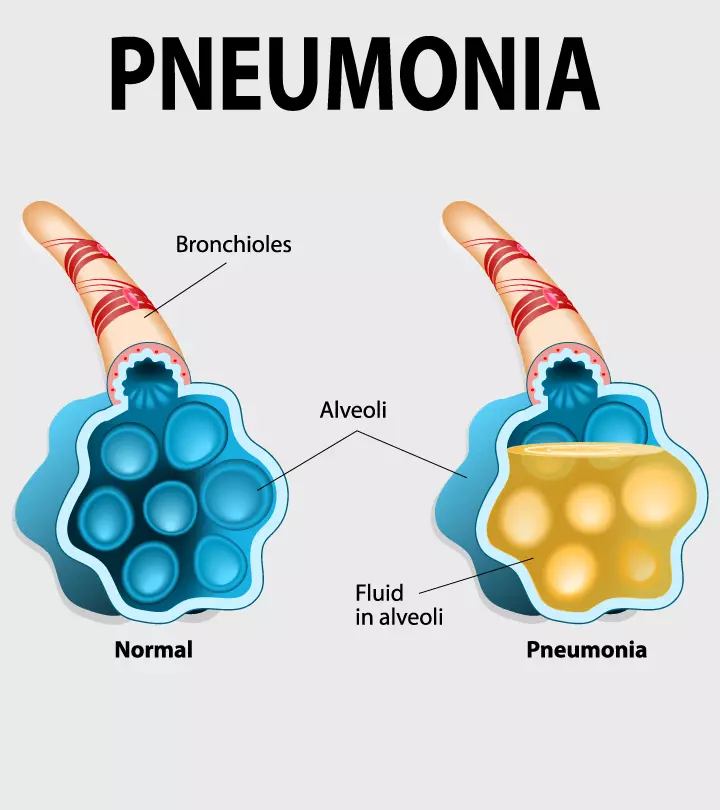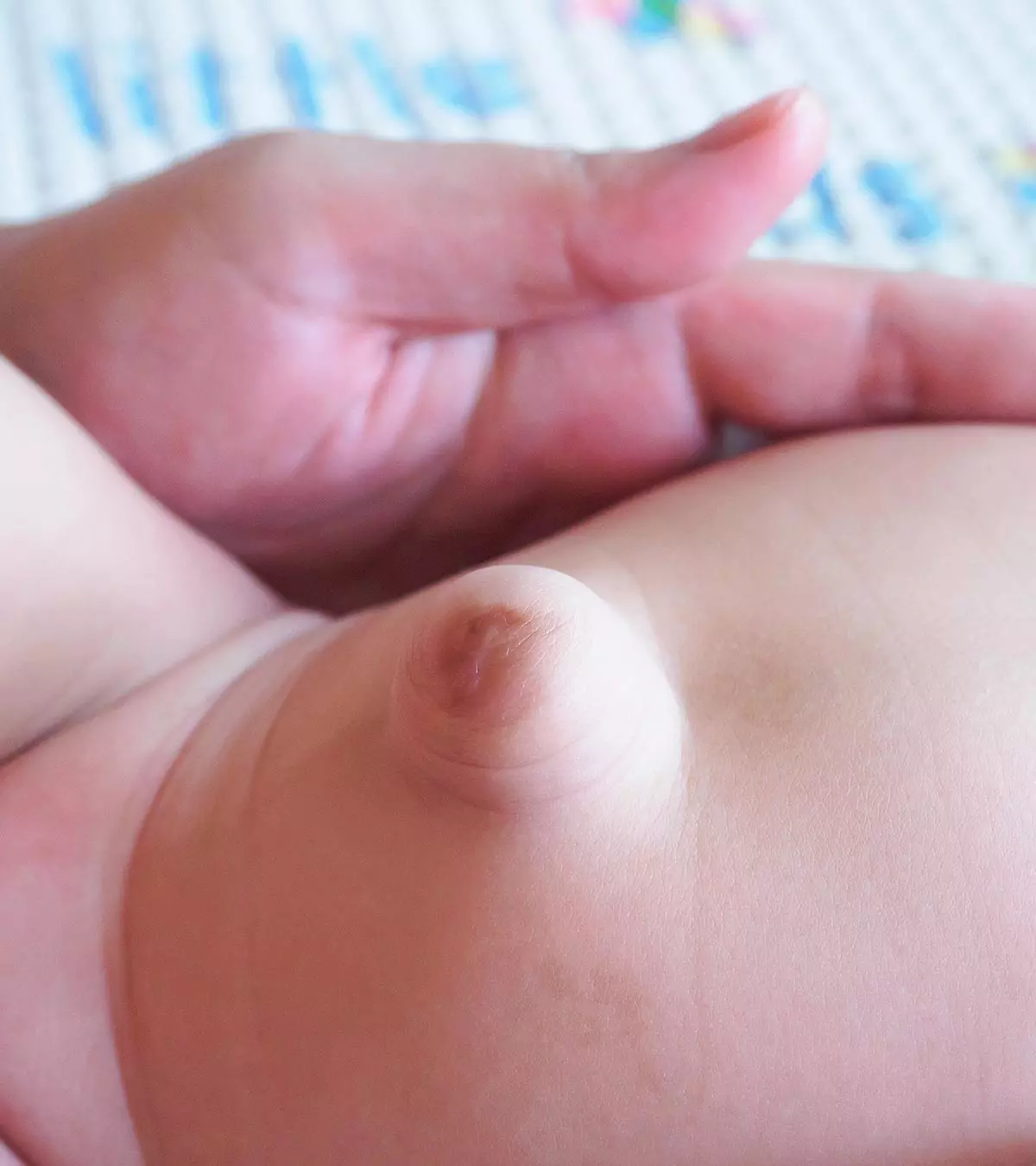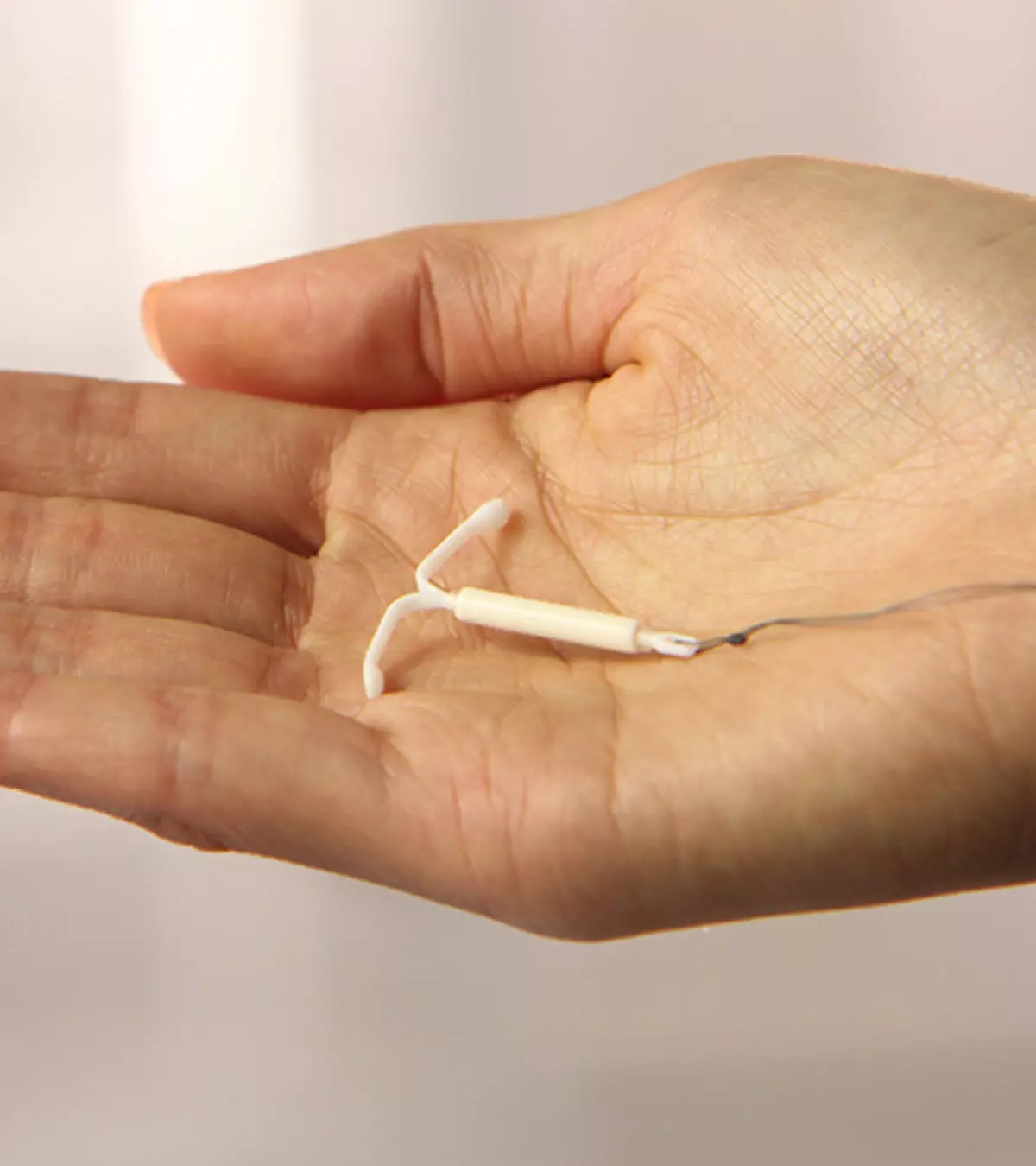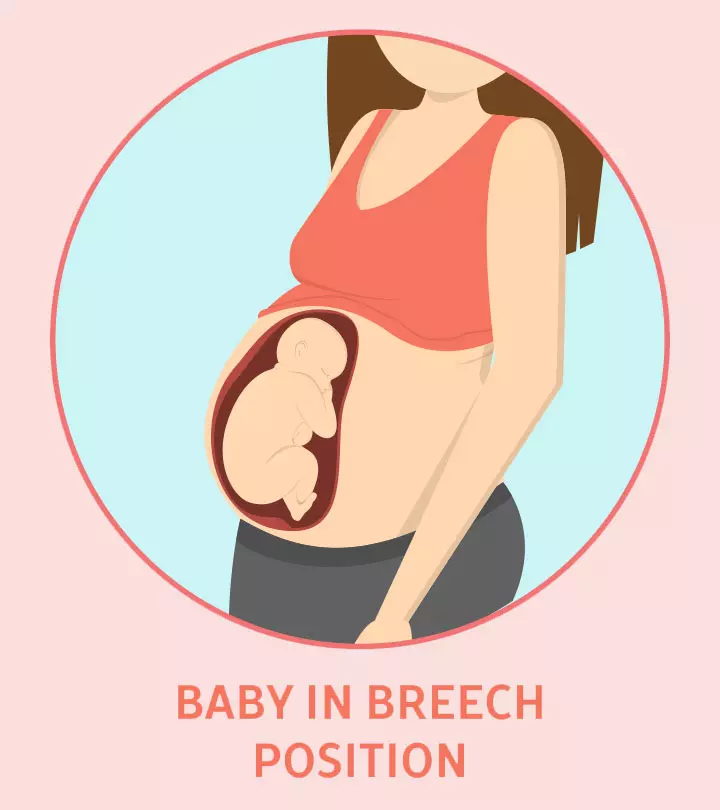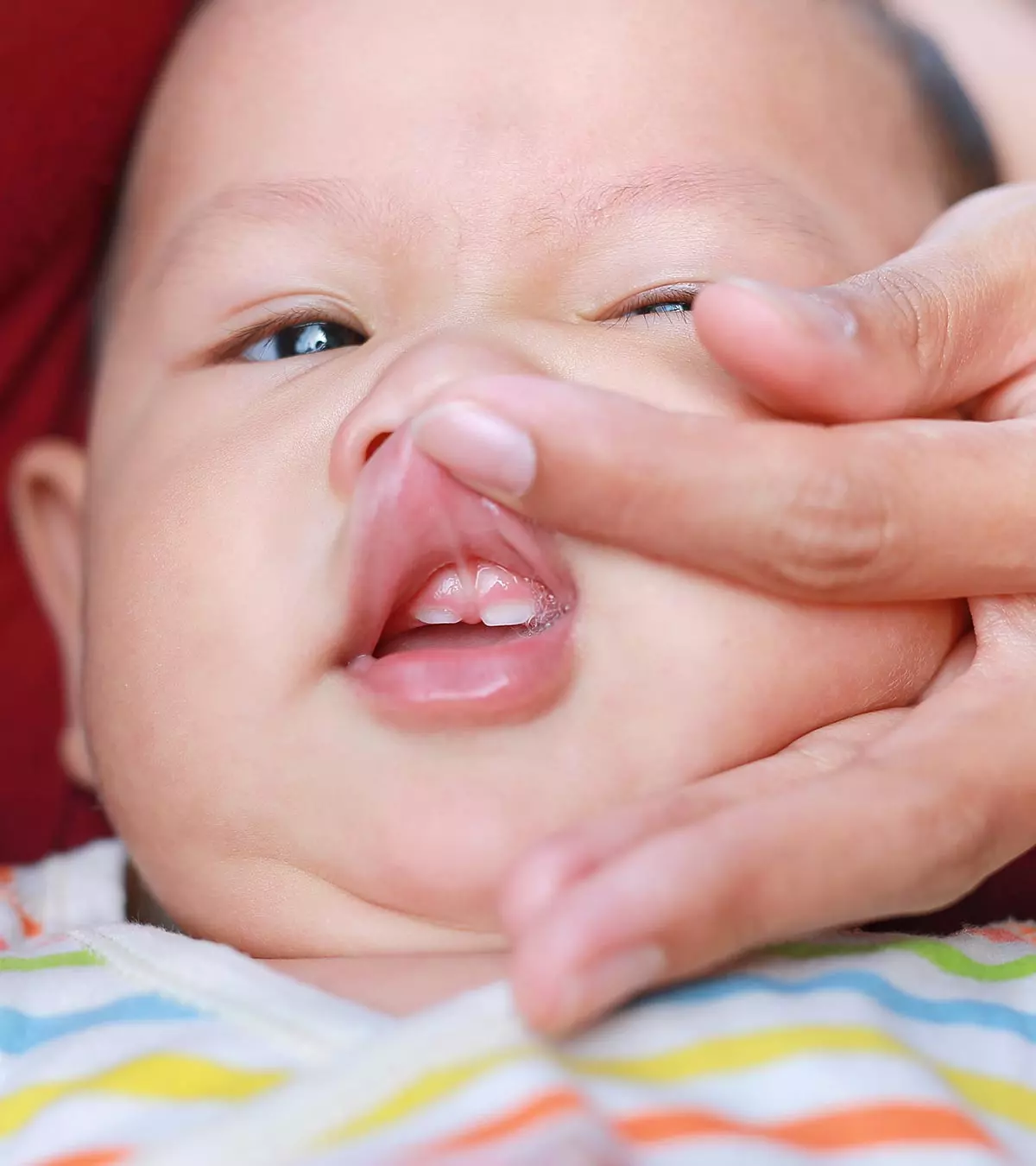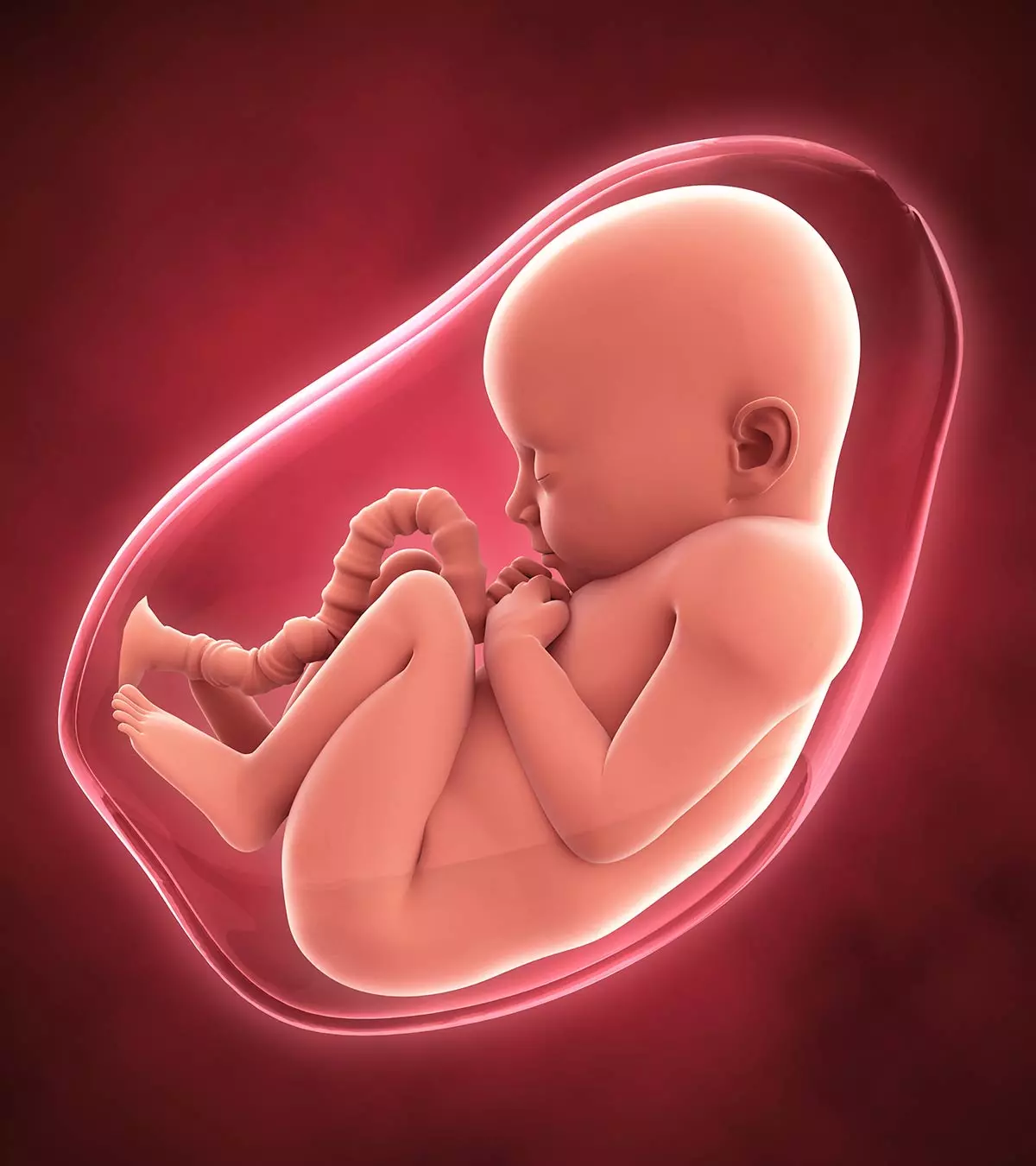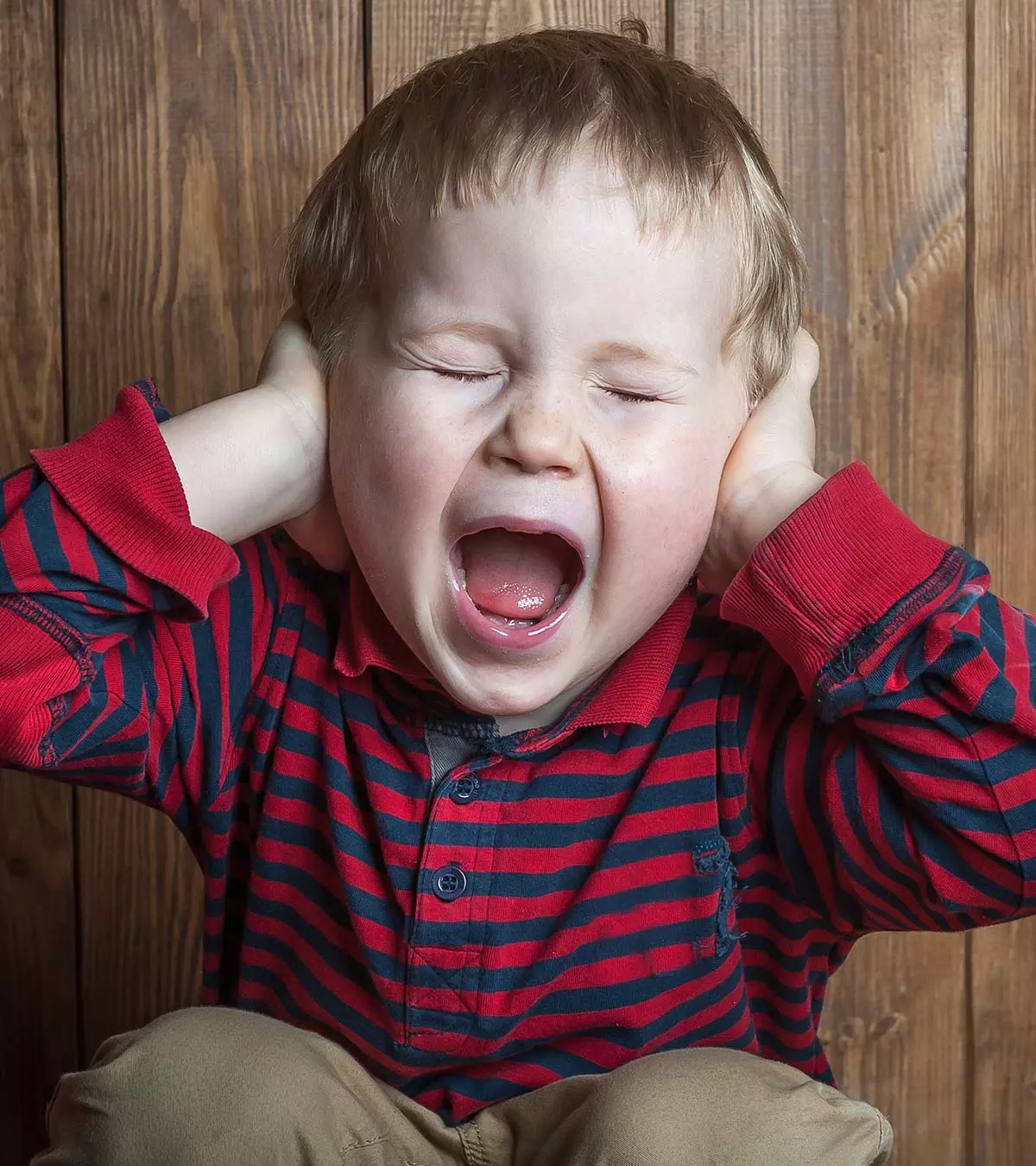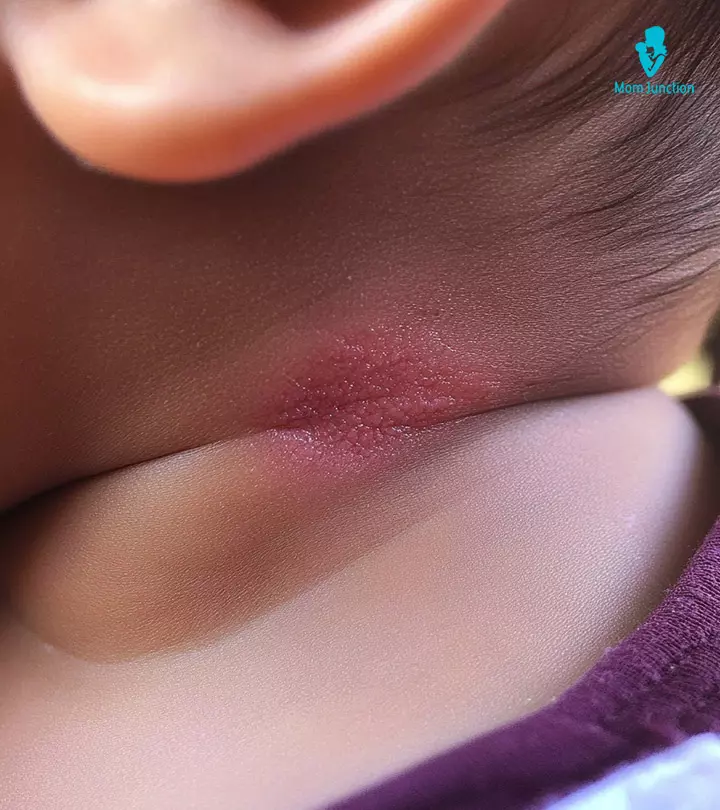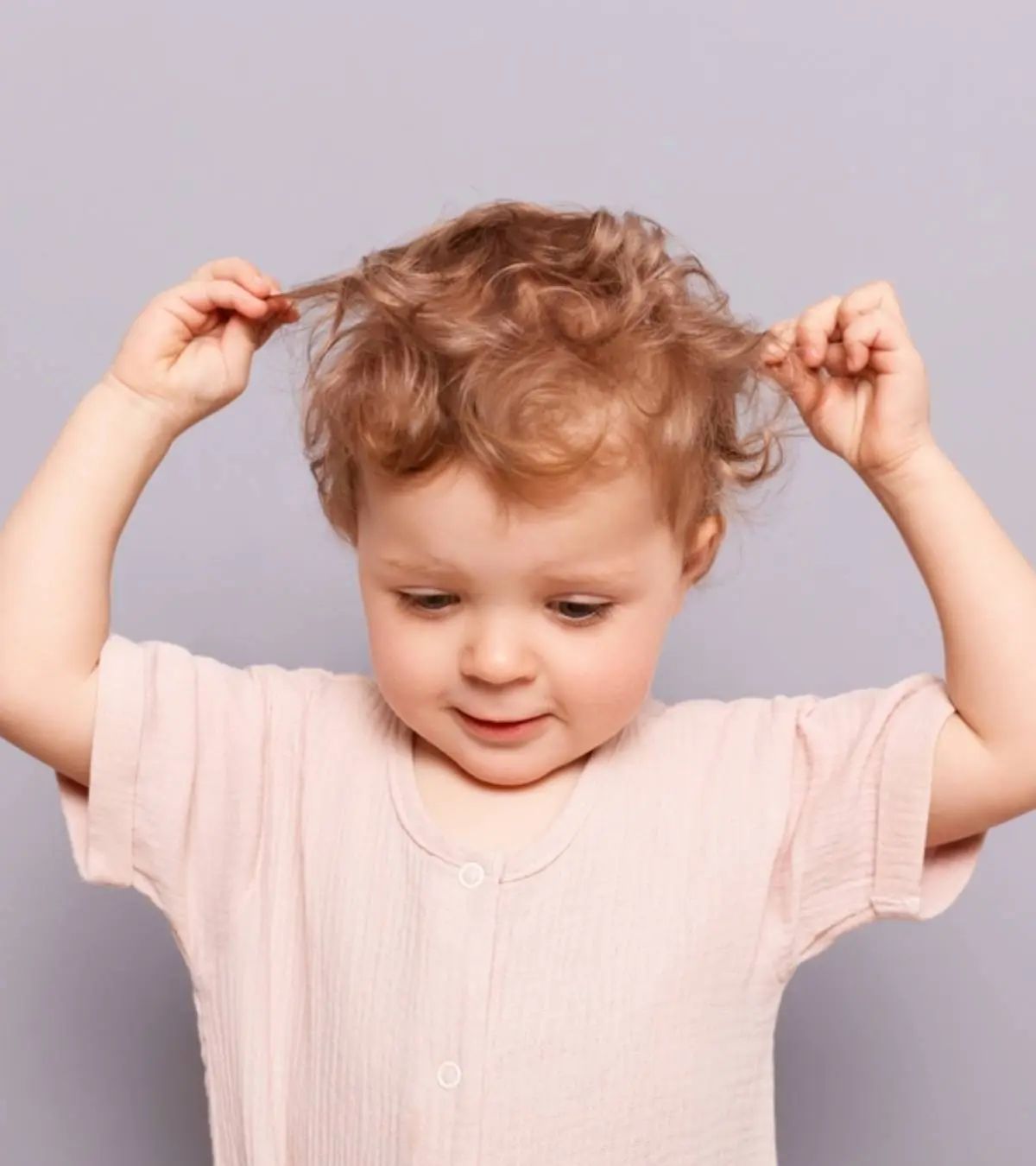
Image: Shutterstock
Hair-pulling in babies is a common but unpleasant behavior that can potentially affect them. Babies mostly do this for harmless reasons. However, if a baby pulls their own hair excessively, it could signal an underlying condition. Moreover, long-term hair-pulling behavior could result in excessive hair loss, causing permanent damage in certain situations.

Knowing why a baby pulls their hair could help you determine if it’s a cause for concern. In this post, we discuss the numerous reasons for hair-pulling behavior in children, how to deal with the problem, and when to seek medical help.
Key Pointers
- Your baby may pull their hair to calm themselves during stressful situations or just out of habit.
- Try to figure out what could be causing your baby’s hair-pulling habit and address it.
- If you observe that your child’s hair-pulling behavior is causing scalp bleeding or has become severe, consult a doctor.
Why Do Babies Pull Their Hair?
Below are some of the reasons why a baby pulls own hair.
- Self-soothing mechanism: A baby may pull their hair to calm themselves during situations they find stressful or whenever they feel an urge to soothe themselves for no specific reasons. You may notice your little one pull their hair when they experience anxiety, such as separation anxiety. Hair-pulling for self-soothing could be accompanied by other self-soothing actions, such as thumb-sucking (1).
- Experimentation: Babies older than six months may pull their hair as a way to explore cause and effect. They could be curious to see how the hair strands react when tugged and how their parents respond to this action (2). It is not something to be concerned about since it is part of the little one’s usual behavior.
- Self-awareness: Babies become aware of their bodies as they grow older, and their awareness usually increases significantly between the ages of eight and 12 months. An infant between these ages may explore various parts of the body, such as the nose, toes, and even hair. The baby may repeatedly tug at their hair and might do so in a situation where they become more self-aware, such as when looking at themselves in the mirror (3)

- Habit: A baby could pull their hair out of habit with no noticeable trigger or reason for it. Some babies may have the habit of casually tugging hair only at specific places, such as at a daycare or when in the park (1). It could be their way of providing themselves with self-stimulationiAn activity that may cause a sense of joy or motivation in a person. since it makes them feel good about it. Studies have shown that benign hair pulling induced by the need for tactile stimulation for stress coping may resolve independently (9).
- Frustration and tantrum: According to the American Academy of Pediatrics (AAP), some older babies and toddlers may pull hair out of frustration or when experiencing tantrums (4). It is likely to be accompanied by other signs of a tantrum, such as yelling and screaming. The toddler may pull the hair in front of a parent or caregiver to communicate annoyance. Toddlers who pull hair out of tantrums may often pull or try to pluck someone else’s hair or hair locks.

- Trichotillomania: It is usually the only serious cause of hair-pulling behavior in babies. Trichotillomania is a type of compulsive disorder where a person may feel a repeated urge to pull their hair (5). It is a mental disorder similar to obsessive-compulsive disorder and may occur in very young children, too. Studies indicate that while older children may be aware of their urges and indulge in focused hair-pulling behaviors, younger babies may do it automatically (6). It is not known what causes trichotillomania, but genetic and environmental factors may play a role.
 Quick fact
Quick factWhen To See A Doctor?
Hair-pulling behavior in babies is usually nothing to worry about. However, you may consult a doctor in the following scenarios.
- Baby pulls hair to an extent it causes bleeding
- You notice bald patches on the scalp
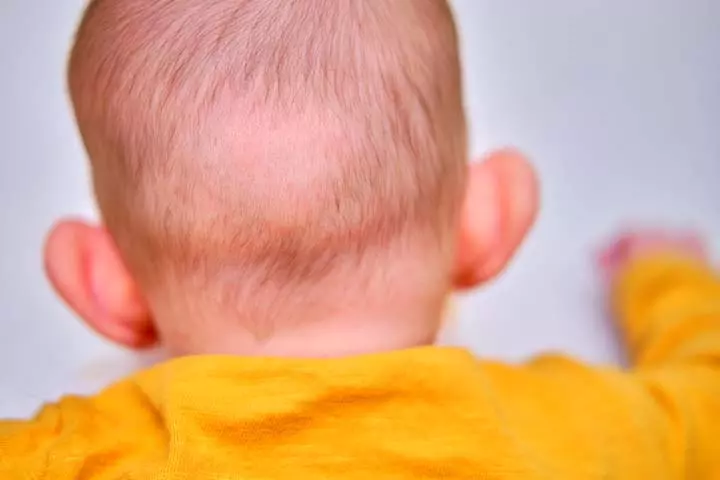
- The hair-pulling behavior is always accompanied by colic
- Baby also pulls eyelashes and eyebrows
Board-certified diplomate of the Philippine Pediatric Society, Dr. Maria Carmela Villania-Mamauag, advises, “Consult a healthcare provider if hair pulling leads to noticeable hair loss (alopecia), bleeding, infection, hair ingestion, or if other symptoms or complications arise as a result of the behavior.” The pediatrician could ask you multiple questions about the baby’s medical history, behavior, and any family history of similar behavior or mental disorder. It could help rule out the presence of serious causes, such as trichotillomania, and other hair loss-related conditions, such as alopecia areataiAn autoimmune condition where a person experiences hair loss in an unpredictable pattern. , which may have nothing to do with hair-pulling behavior.
How To Stop Babies From Pulling Their Hair?
Pediatrician Dr. Raashid Hamid advises, “Dealing with a baby’s hair-pulling can be stressful for parents. How parents respond to hair-pulling can influence the baby’s behavior. Reacting with too much attention or frustration may inadvertently reinforce the habit. Instead, calmly redirecting the baby’s attention and offering positive reinforcement for alternative behaviors can be more effective.”
Below are the various ways to discourage your baby from pulling their hair.
- Provide alternatives for self-soothing: Most babies tend to pull their hair to soothe themselves. You may provide them alternatives to prevent them from reaching for their hair whenever they need to soothe themselves. For instance, you could provide them with soft toys or a soothing blanket—items that provide a sense of security. Pacifiers, too, are a great choice to help a baby to self-soothe and stay calm. You may also consider swaddlingiWrapping a baby in a cloth to protect them from their natural reflex. or white noise to calm your baby whenever they seem stressed.
- Address the triggers: Does your baby pull hair before bedtime? The chances are that they are tired, and pulling or yanking their hair soothes them. You may try identifying the possible triggers for the hair-pulling behavior and address them accordingly. Setting a routine for each day and a bedtime routine before going to bed at night could help avoid common triggers, such as tiredness, boredom, and sudden change in the activity.

- Distract the baby: It works great when your baby pulls hair with no specific triggers, but at certain places. For instance, if your baby has a habit of pulling hair while strolling outdoors, provide them with a toy to keep them engaged. You may also keep a close watch on their actions so that you may distract them before they tug their hair. Some other ways to distract the baby are talking, singing, pointing at interesting objects, or playing games, such as peek-a-boo.
- Use simple words to discourage the baby: Use a specific word or phrase when your baby begins to pull their hair. You may say “No” or “Don’t do that” to communicate your disapproval of the behavior (2). Avoid being too stern since it may cause the baby to repeat the behavior only to test your reaction. Instead, use a flat tone that expresses displeasure and maintain eye contact with the baby when you say it. The baby will understand that it is an inappropriate behavior eventually.
- Set rules and reinforce positive behavior: Older babies and toddlers could be discouraged from pulling their hair through rules. For instance, set a rule that the moment your toddler feels like pulling their hair, they will reach out to you or the nearest caregiver. You may also teach them to walk out of the situation when they feel the urge to pull their hair. Offer praise when your baby engages in these alternative soothing behaviors.
 Quick tip
Quick tip- Therapy for trichotillomania: A diagnosis of trichotillomania may require time since the doctor may assess the baby again at an older age to conclude the presence of the disorder. If your child has been diagnosed with trichotillomania, they could require cognitive behavior therapyiA method used to change a person’s thinking patterns and negative thoughts to positive ones. to improve the self-awareness of the inappropriate behavior and control the urge or stimulus to pull hair. One of the cognitive behavior therapies proven quite effective is habit reversal therapy. This technique involves observation for triggers, high-risk times, and competing responses for hair pulling. Once observed, the baby can be given an alternative stimulus to pick at without injuring themselves. This stimulus may be as simple as a fidget toy or hair band. Alternatively, the therapist may even use an alternative strategy called stimulus control, where they put a cap on the baby. It may restrict their access to the hair and keep them from pulling it. They may also tape the baby’s fingers with mittens or bandages, limiting their grasp reflex and restricting direct access (7). Nevertheless, you may consult your doctor or psychologist to determine the best therapy for your child.

Frequently Asked Questions
1. Is hair pulling a sign of autism?
Hair-pulling behavior may uncommonly occur in individuals with autism (8). However, it is not a significant sign of autism. There are several prominent early signs of autism, and hair-pulling behavior is not one of them. Your baby will require multiple screenings and autism-specific screeningiAn age-based assessment to recognize developmental disabilities in children. at 18 and 24 months of age to conclude the presence of autism.
2. Can trichotillomania go away?
There is no specific cure for trichotillomania since its causes are not well-understood. However, appropriate therapy and lifestyle changes could help a child manage the condition effectively, leading to the suppression of triggers and less to no desire for pulling the hair (9).
3. What does it mean if my baby grabs my hair?
Babies may pull your hair to grab your attention. They may learn cause and effect by getting your reaction when pulling your hair. It could be their way of exploring reactions by primary caregivers to different actions.
4. Why does my baby pull her hair when feeding?
Babies pull their hair to self-soothe or explore a different texture. You may try diverting them to touching something else, such as a blanket.
5. Is hair pulling a form of stimming?
Pediatrician Dr. Bidisha Sarkar says, “Stimming is commonly used as an umbrella term for repetitive behaviors that serve no apparent purpose other than providing comfort or sensory input. It includes actions such as hand flapping, rocking, and head banging. While it is possible that hair pulling could be stimming, it is important to note that it could also be a sign of other underlying issues.”
If your baby pulls own hair, you may find it unique and would like to understand the reason behind it. In most babies, the behavior may be a self-soothing mechanism or a result of increased self-awareness or a habit. These reasons are not worrisome, and the behavior may go away eventually. However, sometimes babies may pull their hair due to trichotillomania, a compulsive disorder. In such cases, constant hair pulling can cause hair loss in babies. If you find bleeding or bald patches on your baby’s scalp, consult a doctor promptly. They may be able to detect the underlying condition and help suggest ways to manage it.
Hair-pulling behavior or trichotillomania can be associated with the ingestion of hair or trichophagia in some babies. However, some may not ingest the hair after pulling it. Go through the infographic to learn more about trichophagia in babies.
Some thing wrong with infographic shortcode. please verify shortcode syntax
Illustration: Reasons Why Baby Pulls Own Hair And Tips to Manage
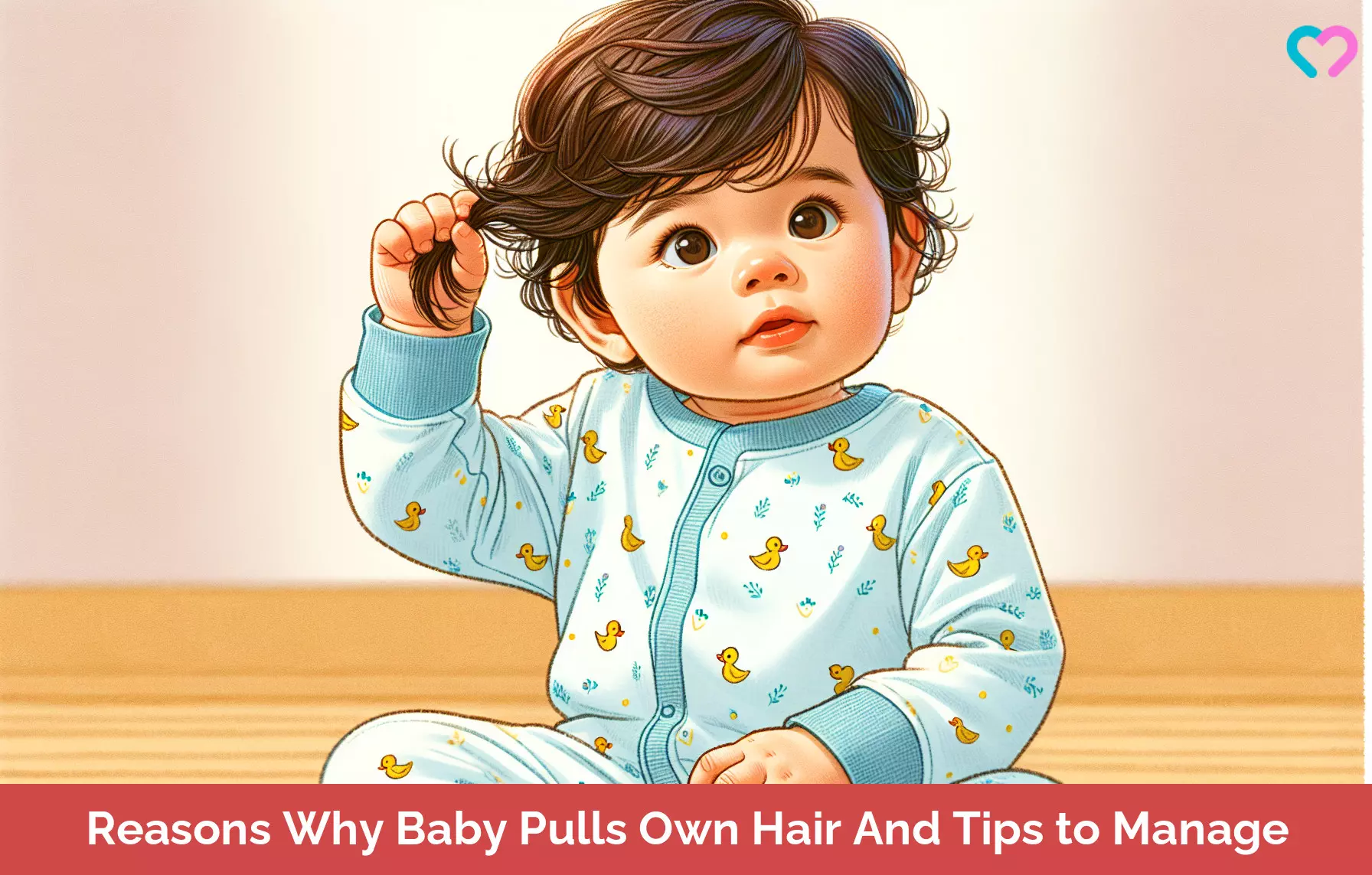
Image: Dall·E/MomJunction Design Team
Parents may often have a number of questions surrounding trichotillomania in children. Learn how to support your child and help them cope with this condition with this video.
References
1. Ruth Golomb, Toddler and Pre-School Hair Pulling; The TLC Foundation
2. Biting, pinching and hair-pulling; Raising Children Network
3. Emotional and Social Development: 8 to 12 Months; American Academy of Pediatrics
4. Challenging Case: Behavioral Changes; American Academy of Pediatrics
5. Developmental Milestones: Birth to 12 Months.
6. Baninder Kaur Baidwan and Cara J Haberman; Hair loss in an infant presenting with failure to thrive; Sage Open Medical Case Reports, NCBI.
7. Hair pulling and skin picking: How to help your child stop repetitive behaviors UC Davis Health.
8. Ruziana Masiran, Autism and trichotillomania in an adolescent boy; U.S. National Library of Medicine
9. Habit Reversal Training; USF Health
Community Experiences
Join the conversation and become a part of our nurturing community! Share your stories, experiences, and insights to connect with fellow parents.
Read full bio of Dr. Maymunah Yusuf Kadiri
- Dr. Raashid Hamid is a consultant in the department of Pediatric Surgery at GMC hospital and associate professor of Pediatric and Neonatal Surgery at SKIMS, Jammu & Kashmir, India. He has four years of experience and specializes in general surgeries, including appendectomy, cholecystectomy, and exploratory laparotomy.
 Dr. Raashid Hamid is a consultant in the department of Pediatric Surgery at GMC hospital and associate professor of Pediatric and Neonatal Surgery at SKIMS, Jammu & Kashmir, India. He has four years of experience and specializes in general surgeries, including appendectomy, cholecystectomy, and exploratory laparotomy.
Dr. Raashid Hamid is a consultant in the department of Pediatric Surgery at GMC hospital and associate professor of Pediatric and Neonatal Surgery at SKIMS, Jammu & Kashmir, India. He has four years of experience and specializes in general surgeries, including appendectomy, cholecystectomy, and exploratory laparotomy. - Dr. Maria Carmela Villania-Mamauag is a board certified diplomate of the Philippine Pediatric Society with a degree of Doctor of Medicine from Our Lady of Fatima University, Valenzuela City and a Bachelor in Science in Psychology from Saint Louis University, Baguio City which was augmented by a year of Bachelor in Science in Family Life and Child development at the University of the Philippines, Diliman, Quezon City.
 Dr. Maria Carmela Villania-Mamauag is a board certified diplomate of the Philippine Pediatric Society with a degree of Doctor of Medicine from Our Lady of Fatima University, Valenzuela City and a Bachelor in Science in Psychology from Saint Louis University, Baguio City which was augmented by a year of Bachelor in Science in Family Life and Child development at the University of the Philippines, Diliman, Quezon City.
Dr. Maria Carmela Villania-Mamauag is a board certified diplomate of the Philippine Pediatric Society with a degree of Doctor of Medicine from Our Lady of Fatima University, Valenzuela City and a Bachelor in Science in Psychology from Saint Louis University, Baguio City which was augmented by a year of Bachelor in Science in Family Life and Child development at the University of the Philippines, Diliman, Quezon City. - Dr. Bidisha Sarkar is a pediatrician with nine years of experience. She did her graduation in Medicine from NRS Medical College, Kolkata and holds specialization in Pediatrics. Dr. Sarkar currently practices at KIMS Hospital in Hyderabad, India.
 Dr. Bidisha Sarkar is a pediatrician with nine years of experience. She did her graduation in Medicine from NRS Medical College, Kolkata and holds specialization in Pediatrics. Dr. Sarkar currently practices at KIMS Hospital in Hyderabad, India.
Dr. Bidisha Sarkar is a pediatrician with nine years of experience. She did her graduation in Medicine from NRS Medical College, Kolkata and holds specialization in Pediatrics. Dr. Sarkar currently practices at KIMS Hospital in Hyderabad, India.
Read full bio of Shivali Karande
Read full bio of Rohit Garoo
Read full bio of Vidya Tadapatri







